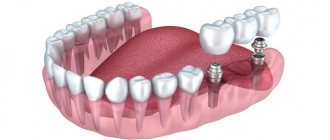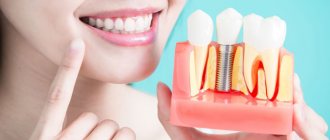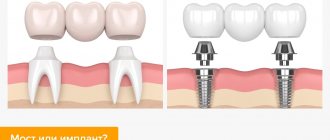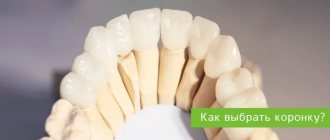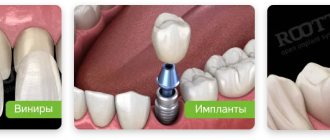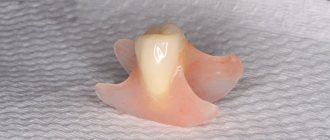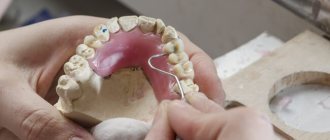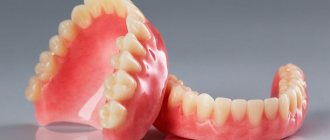Dental implants or bridges are used to restore lost teeth. Both options are functional and aesthetic. However, there are significant differences between them. To fix the bridge, the units adjacent to the defect are depulped and ground down. Due to improper load distribution, they gradually collapse and the jawbone atrophies. For an implant, these problems are eliminated. It is implanted into the jaw without the use of healthy teeth and prevents bone loss. When choosing a method, the patient should focus not only on finances, but also on long-term results.
In the photo - a dental bridge (left) and an implant (right)
What are bridges and dental implants?
A bridge is a permanent dental prosthesis consisting of crowns welded together, the outermost of which are fixed on previously ground living teeth. Used to restore 1-4 missing units in a row. The number of support units is always two. Bridges are usually created from the following materials: metal ceramics, zirconium dioxide. We install only metal-free structures.
Dental implants are artificial analogs of tooth roots that act as supports for individual crowns or dentures. Manufactured from medical titanium, biocompatible with oral tissues. Indicated for single, partial and complete edentia. They are implanted into the jaw using the following methods: classic, express, simultaneously with tooth extraction. They fully restore the functions and aesthetics of the dentition.
About implant brands and price differences
The most expensive implants are those made in Europe and the USA, but this does not mean that they have no alternative. We recommend paying attention to South Korean implants. Many are quite skeptical about products from Asia, but the medical industry of South Korea is not inferior to leading Western countries in terms of technological solutions. One of the best South Korean implant systems is Osstem. The company offers a wide range of implants and abutments that can solve the problem of partial and complete tooth loss in patients of various age and social groups. The possibility of 3D planning and the availability of special sets of tools for installing Osstem implants in conditions of bone deficiency makes it universal.
It is very important that the selected company producing implants has a distributor in your city who would not only sell this system, but also conduct courses, seminars, master classes and provide all the necessary technical support to doctors and patients. There is no need to save on your health by trusting systems that have not received a license and do not have official representation in Russia.
Pros of the methods
If we compare both options, then both the bridge and the implant are non-removable structures, matched to the color and shape of the patient’s natural teeth, and restore the functionality of the dentition. However, each method has individual advantages.
Pros of bridges on your teeth:
- shortened treatment periods;
- minimum contraindications;
- affordable price.
Advantages of implants:
- functional, aesthetic;
- allow you to restore any number of lost units;
- suitable for restoring terminal defects of the dentition;
- prosthetics with single crowns, bridges and complete dentures;
- have increased stability;
- distribute the load evenly, protect the jaw bone from resorption;
- crown replacement is performed without removing the titanium root;
- have a lifetime service life (for Nobel Biocare models).
The main advantage of implants compared to classic bridges is that to install the prosthesis, it is not necessary to grind down the units adjacent to the defect.
The role of the doctor in choosing a treatment method
Often, already at the first consultation, the patient categorically declares: “I need an implant!” It sounds so confident that it seems that only the lack of appropriate tools is keeping the patient from doing it himself.
Before receiving the right to treat patients, a doctor studies for 6 years, then for 2 years he can undergo highly specialized training. Every 5 years he goes to improve his qualifications, but in fact he studies all his life, constantly gaining new experience, skills and knowledge. What can be concluded? Only a doctor can draw up an optimal rehabilitation plan and carry out the necessary manipulations.
Before starting treatment, a comprehensive clinical and radiological examination is carried out, and if necessary, the patient is referred for consultations to doctors of related specialties. Not only the extent of the dental defect is assessed, but also the condition of each remaining tooth, the quantity and quality of bone tissue, and the presence and severity of the patient’s general diseases. Only then will it be possible to make a diagnosis and formulate a treatment plan. Of course, the patient should be fully informed about both the treatment plan and alternative methods.
In conclusion, we would like to advise patients who have not decided on the choice of treatment method and who have no serious contraindications to pay attention to dental implants.
Contraindications
Among the limitations to classical bridge prosthetics:
- diseases of periodontal tissues (periodontal disease, periodontitis);
- serious malocclusion;
- pathological abrasion of enamel;
- inflammation of the oral cavity;
- osteoporosis and other diseases of the jaw bone tissue.
Dental implants are contraindicated in the following cases:
- high blood pressure;
- blood diseases;
- malignant neoplasms;
- diseases of the cardiovascular, endocrine, nervous systems;
- uncompensated diabetes mellitus;
- mental disorders;
- HIV AIDS;
- tuberculosis;
- infectious processes in the body;
- gum disease;
- age up to 16 years.
Implantation is also not performed in case of relative contraindications - lactation and pregnancy in women, if the patient has bad habits (smoking, alcohol abuse, drug use).
Restrictions on installing an artificial root
Implantation is indicated when a person is missing one or more teeth and there is significant destruction of the nearest ones. Dentists also advise installing artificial roots in cases where the patient is categorically against grinding down adjacent teeth. It is recommended to install an implant in cases where it is not possible to install a bridge.
Crowns should be placed in situations where:
- There is no protective layer of the tooth;
- Increased abrasion is observed;
- Most of the tooth is damaged by caries.
A crown differs from an implant in that the latter can be used to restore a lost tooth, while the former helps preserve a damaged one. The doctor chooses what is the best option in each specific case.
There are a number of absolute contraindications for installing an artificial root:
- Various neoplasms;
- Diabetes mellitus in a severe stage of development;
- Tuberculosis;
- Disturbances in the functioning of the nervous system;
- Various mental disorders;
- Blood diseases;
- Inflammatory diseases of an infectious nature, localized in the area of the mucous membranes of the mouth;
- Weakening of the immune system;
- Exacerbations of various chronic diseases.
When placing an implant, the doctor must take into account the condition of the hard tissues of the jaw and their integrity. If the last point is violated, an artificial root cannot be installed.
There are also a number of relative contraindications for implantation of a metal pin:
- Pregnancy, breastfeeding;
- Insufficient compliance with hygiene measures;
- Bite disorders, congenital jaw defects;
- Inflammatory processes in the gums;
- Excessive smoking, alcohol abuse.
When deciding to install a titanium root, you should take into account all these contraindications and consult with an experienced specialist. Only after all possible risks have been eliminated is prosthetics using a pin possible.
Possible complications
After installing the bridge, the patient may encounter the following problems:
- sensation of a foreign body in the mouth in the first 5-7 days;
- pain (if you have this symptom, we recommend that you consult a doctor);
- food getting under the prosthesis (in case of improper fixation of the structure);
- peeling off crowns (occurs with bruxism in a patient);
- exposure of the neck of the supporting unit.
Complications after implantation occur in less than 5% of clinical cases. Among them:
- bleeding (occurs when a patient has a blood clotting disorder);
- pain (in the first 5-7 days this is a normal reaction to surgery, after this period it is a reason to consult a doctor);
- seam divergence;
- perforation of the bottom of the maxillary sinus;
- damage to the mandibular nerve (accompanied by numbness);
- peri-implantitis (inflammation of the gum tissue around the implant);
- design rejection.
Implants are a profitable solution
Classic bridge prosthetics is less expensive than implantation. However, if you take into account the costs of depulping the supporting units before installing a bridge and the need to replace the prosthesis every 7 years (in the best case scenario), implants are a profitable solution. Titanium roots do not destroy healthy teeth and have a lifetime service life, and zirconium dioxide crowns will not require replacement for at least 20 years.
Levin Dmitry Valerievich
Chief physician, Ph.D.
What is better to put on the front teeth?
Implantation is the best option when restoring anterior units. This is due to increased demands on aesthetics. The bridge initially corresponds to them, but gradually, due to atrophy of the jaw bone, it sags, becomes mobile, and a gap appears between it and the gum. The implant, on the contrary, preserves the healthy appearance of the gums and compacts the surrounding bone tissue. As part of the classical installation method, the formation of the correct gingival contour is additionally carried out. Aesthetics do not deteriorate throughout the entire service life of the structure.
Indications for installation of bridges
Let's look at situations where it may be recommended to replace missing teeth with bridges. Such indications may include:
- absence of teeth (one or more);
- financial difficulties that do not allow the patient to use dental implants;
- chronic diseases or conditions in which implantation is contraindicated (dystrophy of the jaw bone, pathology of the oral mucosa, general chronic diseases, etc.).
The main advantage of replacing missing teeth with bridges is that they are cheap and accessible to people of low income. However, due to a host of shortcomings, bridges are gradually giving way to more advanced types of prosthetics.
What to choose for a chewing tooth
In this case, the bridge and the implant have their own advantages and disadvantages. A bridge allows you to quickly restore the functionality of the dentition and cope with the chewing load normally. However, uneven distribution of pressure gradually leads to destruction and removal of supporting teeth.
The implant does not have a destructive effect on neighboring units; in all respects it is identical to a natural tooth. However, when installing a titanium root in the masticatory region, loading with a full-fledged prosthesis is not allowed until the artificial root has completely engrafted.
Pros and cons of implantation
The ideal orthodontic design is created taking into account high aesthetic parameters, especially for the front teeth. And first of all, its functionality must be taken into account. So, an artificial rod with a crown is precisely the only system that meets these requirements. It is tightly fixed in the bone, which prevents atrophy of hard tissues, withstands good chewing load, does not negatively affect the aesthetic properties of the gums, and looks like a natural tooth.
With careful care, a titanium rod will serve patients for a lifetime. And the crown, unfortunately, has to be changed after ten to fifteen years. The bone tissue is loaded evenly and correctly, which prevents loss of its volume, which bridges cannot do. It is worth considering that the absence of a unit for a long time causes displacement of neighboring organs. And then, when installing the rod, it will be necessary to build up the bone and turn the bent unit. This situation is fraught with changes in the oval of the face and bite, drooping of the corners of the lips, the appearance of nasolabial folds, not to mention problems with chewing food. Therefore, to avoid all this, consult a doctor on time!
The ideal aesthetic effect is achieved by working not only with hard tissues, but also with gingival tissues. Removal of the units is usually combined with the placement of an artificial rod. This preserves the shape and color of the soft tissues. More detailed information can be found at the link Single-stage dental implantation. In this case, the patient should not have inflammation, but there should be sufficient bone volume. In such a situation, neighboring healthy teeth will not be harmed in any way. Another advantage is that it is possible to restore not only single teeth, but also the jaw with general edentia. Only a few rods are implanted, and that is enough.
As for the shortcomings, there are practically none. True, there are contraindications. The ban applies to patients with severe cardiovascular diseases, serious diseases of the blood, liver, and connective tissue. The procedure is not prescribed for clients with thyroid pathology, mental disorders, allergies to antiseptics and antibiotics. Implantation is not performed if you are taking bisphosphonates systematically, which affect bone structure. But there is good news: in modern dentistry, the list of prohibitions depends on the installation technology.
Clinical cases
- If one tooth is missing . When restoring a single defect, the condition of neighboring units is taken into account. If they are healthy, it is better to choose implantation, since bridge prosthetics involves depulping the supporting teeth. If they are already pulpless, you can install a bridge.
- If several teeth are missing in a row . The choice of method depends on the extent of the defect. A bridge can restore no more than four missing teeth in a row. Implants - any quantity. In this case, it is not necessary to place a separate rod in place of each lost unit. There are options to fix a smaller number of titanium supports and cover them with a bridge. A bridge on implants does not destroy healthy teeth, the load is distributed evenly, and jawbone loss is eliminated. Plus treatment is cheaper.
- End defect . If the outermost teeth in a row are lost, the only option is implantation, since to fix the bridge at the edges of the defect there must be two supports.
Which teeth are best to insert in case of multiple defects?
If you had to part with several teeth at once, you can restore each of them separately with implantation. To do this, you will have to be patient, because implants need about six months for final engraftment. But the result is worth it: at least for the next 20-30 years, you can forget about prosthetics. If financial capabilities and the condition of the body allow, you can opt for implantation. But there are other options, simpler and less expensive:
- Bridges.
They can restore up to 3-4 missing teeth in a row. - Clasp dentures.
This is one of the varieties of removable structures, which consists of a plastic gum base with crowns attached to it and a metal arch, which is the frame. The clasp is attached to the supporting teeth using hooks (clasps), clasps (attachments) or telescopic crowns. If necessary, it can be easily removed and just as easily installed back. - Removable dentures
. The simplest designs to install, which, however, are inferior in functionality and wearing comfort to both bridge and clasp prostheses. What types of removable dentures are there? They can be nylon - softer and more elastic, or acrylic - tougher, better able to withstand chewing loads. The first ones are more comfortable, the second ones are more functional.
Which dentures are the best in price?
When a patient chooses which dentures are best, they often look for price. You already know the cost of bridge structures, removable ones will cost about 15 thousand rubles, clasp ones - 30-60 thousand rubles with fastenings on clasps or attachments and 60-120 thousand rubles with fastening on telescopic crowns.
What to choose, removable or partially removable dentures – which is better? If you focus only on cost, then the first ones certainly win. But in terms of durability, wearing comfort and functionality, the latter are the leaders.
What is better - dental implantation or bridge?
For a clear example of the strengths and weaknesses of both options, we provide a comparative table.
| Bridge | Implant | |
| Number of missing teeth | 1-4 | any quantity |
| Degree of mastication recovery | average | full identity to a natural tooth root |
| Aesthetics | average | high |
| Recovery time | up to 1 month | 4-6 months, with bone grafting - up to 1 year |
| Difficulty of installation | average | complex |
| Impact on adjacent teeth | subject to depulping and turning | are not used |
| Jaw bone loss | intense | absent |
| Reliability of fixation | mobility of supports is possible in case of diseases and inflammation of periodontal tissues | complete immobility |
| Difficulty of care | Difficulties arise when food gets under the prosthesis | does not require special care |
| Restrictions on food intake | increased load excluded | any load is allowed |
| Comfort while wearing | There is discomfort in the first days after installation | complete comfort |
| Life time | up to 7 years, depending on the condition of the support units | implant - for life, prosthesis - 15 years or more |
| Price | Average | High |
Our dentists recommend that patients do not delay the restoration of missing teeth. Without load, the jawbone begins to atrophy. The method of filling a gap in the dentition must be decided quickly. Each patient, taking into account his financial capabilities, makes his own decision - whether it will be a bridge or an implant.
What teeth to put in if the jaw is completely “empty”?
Unfortunately, it also happens that a person is left completely without teeth on one of the jaws, and sometimes on both at once. What should he do in this case? Of course, you can just come to the dental clinic and ask: “I want to insert teeth - which ones are better? Tell". But it is advisable to understand at least a little about the issue of prosthetics in order to make the best choice. What does dentistry offer for complete edentia? Here are the main ways to restore teeth in this case:
- Complete removable dentures.
Very easy to install structures, which are artificial gums (base) made of acrylic or nylon with crowns fixed on it.When a patient decides to install complete removable dentures, which is better to choose - acrylic or nylon? There is no clear answer here; you need to look at the specific clinical situation and the wishes of the patient himself. In some cases, nylon is preferable, since it looks much better, is more comfortable to wear and can be installed by people in extreme professions (acrylic will not suit them, because due to its rigidity it can cause injury in the process of a fall or other unforeseen event). But sometimes it’s better to go with acrylic, which is stronger and better withstands chewing loads. When choosing removable dentures for teeth (which is better), you should ask your dentist - he will give individual recommendations.
- Prosthetics on implants.
There are several options for such dental restoration: bridge structures on implants (in case of complete edentia, they are installed in “sections”: several dentures on one jaw), removable dentures on implants (this method is especially recommended for the lower jaw, on which the usual removable structure does not hold very securely) and even clasp ones. Implantation serves as a support for the main prosthesis and makes it more reliable. If the patient is not afraid of serious stress on the body and is ready to invest a lot of money in restoring the health of his oral cavity, he can carry out a complete implantation of the entire dentition; modern technologies allow this possibility. - All-on-4.
A modern and very reliable method of restoring teeth, which is much more economical than full implantation. The essence of the method is that four implants are implanted into the jaw, on which the main structure is then installed, restoring the entire dentition.
Dental surgeon, implantologist at the 32 Dent clinic Sergey Leonidovich Yakubovsky: “We recommend All-on-4 prosthetics to patients with complete edentia as a gentle and very reliable way to regain their teeth. Full implantation is quite a serious burden on both the body and the patient’s wallet. And here there is an opportunity to restore the dentition at an affordable price, for a long time and with good aesthetics.”
Which teeth are better to insert: prices for prosthetics
Complete removable structures will cost 15-55 thousand rubles. If you plan to install them on implants, the cost of implantation will be added here, so the price will be higher - from 58 to 80 thousand rubles. All-on-4 prosthetics will cost approximately 50-60 thousand rubles (depending on the chosen main prosthetic design and types of implants).
Which dentures are best to install?
? It is advisable to at least have a rough idea of what you want when going to the dentist. And the doctor will help you navigate and choose the optimal method for a particular case, tell you about all the pros and cons of the chosen method and carry out proper installation. The main thing is to choose a good doctor!

